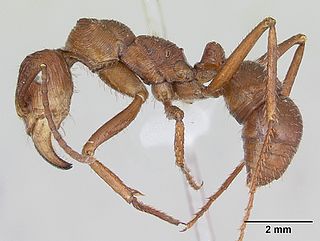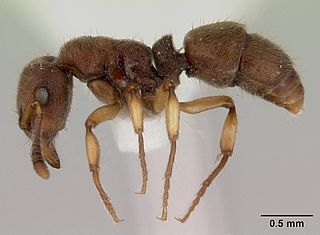
Pogonomyrmex anergismus is a species of workerless inquiline ant in the subfamily Myrmicinae native to Arizona, New Mexico, and Texas that parasitizes Pogonomyrmex rugosus and Pogonomyrmex barbatus nests.

Ectatomminae is a subfamily of ants in the poneromorph subfamilies group containing four extant and three extinct genera in two tribes. The subfamily was described in 2003 when Barry Bolton divided the Ponerinae subfamily into six subfamilies. Heteroponerinae used to be an independent subfamily, but was merged into Ectatomminae in 2022. The taxonomical position of Ectatomminae was further upheld in a genomic reanalysis conducted with alternate methods in 2024.

Gnamptogenys is a genus of ants in the subfamily Ectatomminae. The genus has a wide distribution. It is known to occur in the Nearctic, Neotropic, Indomalayan and Australasian realms. Camacho et al, 2022 revised this genus, significantly reducing its size to only 32 valid extant species and 5 valid fossil species by splitting off most species into four formerly synonymized genera Alfaria, Holcoponera, Poneracantha, and Stictoponera.

Typhlomyrmex is a genus of ants in the subfamily Ectatomminae. Known from the Neotropics, the genus has a wide distribution. Some species are restricted in range, while for example Typhlomyrmex rogenhoferi is known from southern Mexico to northern Argentina. Little is known about their biology. The name "Typhlomyrmex" means "blind ant", as this genus contains only blind ants. Previously classified under the monotypic tribe Typhlomyrmecini, it was merged into Ectatommini in 2022.

Ectatomma is a Neotropical genus of ants in the subfamily Ectatomminae. The genus contains 17 described extant species and one extinct species.

Heteroponera is a genus of ants in the subfamily Ectatomminae. The genus is known from the Neotropics and Australasia.

Poneracantha triangularis is a Neotropical species of ant in the subfamily Ectatomminae. Native to the forests of South and Central America, P. triangularis is a predatory ant that feeds on millipedes. In its native range, this species is known from Buenos Aires, Argentina in the south to Costa Rica in the north, with records from eight countries in South America, and two countries of Central America. The first records of P. triangularis outside its native range came from Florida beginning in 1985 and Alabama in 1996.

Holcoponera is a genus of ants in the subfamily Ectatomminae. They are found in the Neotropics, Southeast Asia, and Oceania. The genus was synonymized under Gnamptogenys for a long time, however Camacho et al. 2022 reinstated the validity of this genus.

Ectatomma tuberculatum, known in Qʼeqchiʼ as the kelep, is a Neotropical species of ant in the subfamily Ectatomminae. Common in the Neotropics, the species is found from Mexico to Argentina. It is a host to the related social parasite Ectatomma parasiticum, the only known parasitic species in the subfamily Ectatomminae.

Pseudectatomma is an extinct genus of ants in the formicid subfamily Ectatomminae described by from fossils found in Europe. The genus contains two species dating from the Eocene, Pseudectatomma eocenica and Pseudectatomma striatula.

Camponotus inflatus, also called the Australian honey ant and black honey ant, is a species of carpenter ant native to Australia. Its workers can be used as repletes like honeypot ants, and Aboriginal Australians traditionally eat the repletes as food. They have many names in the Australian Aboriginal languages, including "Wuukurta" and "Yarumpa", and they are considered a local delicacy.

Aphaenogaster uinta is a species of myrmicine ant native to the western United States and possibly Saskatchewan.

Myrmecocystus yuma is a species of honeypot ant native to the southwestern United States and a small part of Northern Mexico. This species, like most in the genus Myrmecocystus, create worker repletes.

Polyrhachis mucronata is a species of ant in the subfamily Formicinae native to Oceania and Southeast Asia.

Amoimyrmex is a genus of leafcutter ants that occur in southern South America, specifically Bolivia, Paraguay, Uruguay, Argentina, and southern Brazil. All three of its species used to belong in Acromyrmex.

Stictoponera is a genus of ants in the subfamily Ectatomminae. They are found in Southeast Asia and Oceania. The genus was synonymized under Gnamptogenys for a long time, however Camacho et al. 2022 reinstated the validity of this genus.

Alfaria is a genus of ants in the subfamily Ectatomminae. They are found in Mexico, Central America, and South America. The genus was synonymized under Gnamptogenys for a long time, however Camacho et al. 2022 reinstated the validity of this genus.

Igaponera is a monotypic genus of ponerine ants native to Amazonas described in 2022 containing one species Igaponera curiosa. First described in 2010 as Pachycondyla curiosa in 2010, I. curiosa was placed in Neoponera for a short time in 2021 before its current placement by Troya et al. 2022.
















